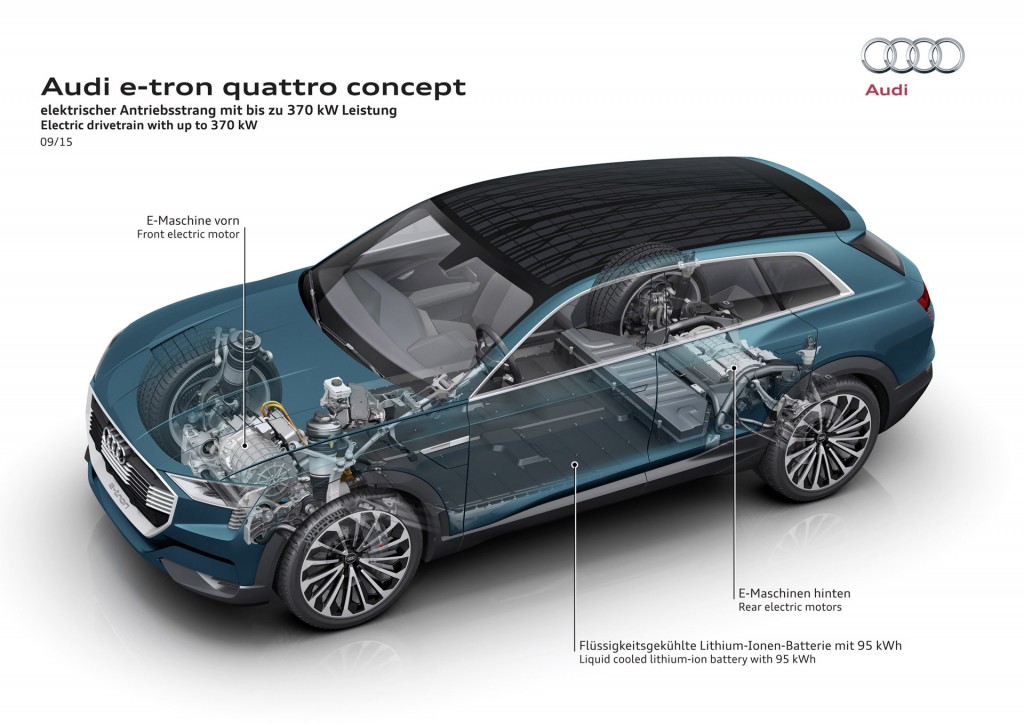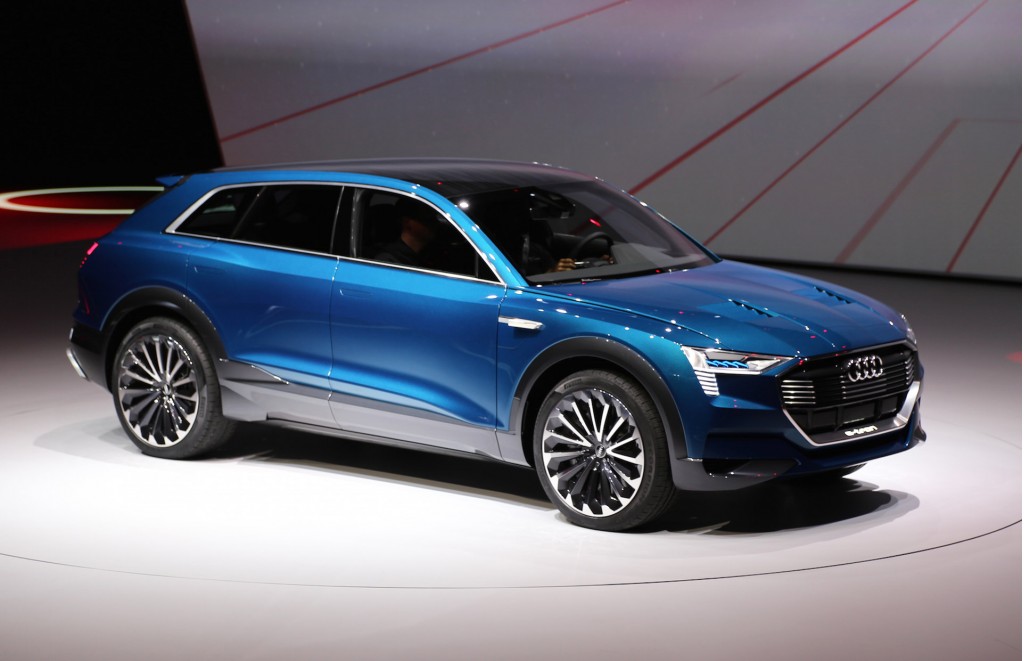It’s increasingly clear that the German prestige brands plan to launch luxury electric cars that will go head-to-head with upstart Tesla Motors and its Model S and Model X.
But a sexy, fast, comfortable, luxurious electric car will not be enough to compete effectively.
The German brands must also provide pervasive networks of fast-charging sites—the equivalent of Tesla’s Superchargers—for the times that their owners decide to take their new electric cars on longer journeys.
DON’T MISS: Germans Vs Tesla In High-End Electric Cars: Will Fast Charging Follow In Time?
Now it appears that Audi plans to do just that.
The luxury volume brand of VW Group told reporters on Friday it will offer a DC fast-charging network for buyers of the production version of its Audi e-tron Quattro, which will arrive during 2018.
The battery-electric five-seat SUV with a 95-kilowatt-hour battery pack (sometimes referred to as the Q6 e-tron) was revealed as a concept in September at the Frankfurt Motor Show.

Audi e-tron quattro concept, 2015 Frankfurt Auto Show
But assuming Audi can provide a luxury electric SUV with 250 or more miles of range, it still faces the need to compete with the growing Supercharger network.
Now numbering more than 1,400 outlets in 231 locations, the Supercharger fast-charging sites are part and parcel of the allure of buying a Tesla Model S or Model X.
Not only do buyers get the car itself, they also get lifetime access to any Supercharger--which will recharge the battery from 20 to 80 percent of its capacity in about half an hour, depending on how many cars are charging at once.
ALSO SEE: Electric-Car Fast-Charging Networks: Competition Heats Up
At a one-day presentation in Madrid of multiple advanced technologies—the carmaker called it Future Performance Day—Audi executive Reinhard Hofmann said it would offer such a network “along with other [carmakers].”
Those would be some combination of BMW, Fiat Chrysler, Ford, General Motors, Mercedes-Benz, Porsche, and Volkswagen—all of which have committed to use the CCS (Combined Charging System) protocol for fast charging.
While current CCS sites are limited to roughly 50 kW, Tesla Supercharger stations already charge at 125 kW.

Tesla Supercharger network, North American coverage - March 2015
The 150-kW network Audi envisions would thus be a large step up in fast charging for much larger packs than the 19- to 24-kWH packs now found in CCS-equipped cars from the Chevrolet Spark EV to the VW e-Golf.
“By the launch date,” Hofmann said, CCS “charging power will be increased to 150 kilowatts”—which would mean that even a 95-kWh pack like that of the e-tron Quattro could recharge to 80 percent capacity in less than 30 minutes.
That would provide “real long-distance capacity,” he said, for the first Audi long-range battery electric vehicle.
CHECK OUT: 2018 Porsche Mission E: 600-HP Electric Sport Sedan Concept Targets Tesla
Even more interesting, Hofmann suggested, would be a longer-term expansion from 150 kW to as much as 350 kW.
The goal, he said, would be that battery recharging “not take any longer time than refueling”—offering “long-distance [electric] mobility with high convenience.”
Ideally, he said, such recharging would be even quicker and more convenient than standing next to your car while you refilled it with gasoline or diesel fuel.

Audi e-tron quattro concept, 2015 Frankfurt Auto Show
For Audi to get to 150-kW DC fast charging, the carmaker must work toward several concurrent advances.
First, existing committee work to define a CCS charging standard that goes as high as 150 kW must reach consensus and issue a published standard—or be very close to doing so.
Second, Audi and some combination of the rest of the CCS partners must agree on how a U.S. network of such sites would be funded and built over the next three to five years.
MORE: How Audi, BMW & Mercedes Plan To Compete With Tesla--And Why (Dec 2014)
The challenge is that while Tesla alone planned, funded, and built its Supercharger network, multiple carmakers with possibly conflicting agendas and product plans must agree how to proceed to build a network that will initially benefit only some of them.
Moreover, there will have to be consensus on how such a network will be branded. Multiple Audi executives were quite clear, as hydrogen fuel-cell expert Rene von Doorn put it, that VW Group is “a carmaker, not an energy supplier.”
“We are not interested in [providing] any fueling infrastructure, except for demonstration projects,” he said.

Audi e-tron quattro concept, 2015 Frankfurt Auto Show
And while von Doorn was alluding to hydrogen fueling stations, Hofmann explicitly reiterated the statement for DC quick-charging sites.
“We want to go on developing cars, not infrastructure,” he said, meaning the company will work with outside partners to provide a “seamless supply” of charging stations for its customers.
In reality, that likely means that Audi will be one of a few automakers—Porsche seems another likely candidate—that provide funding for a much higher-power DC fast-charging network, using the CCS standard, that is built and maintained by one or more third parties.
Whether Audi can offer the same free, unlimited access to DC quick-charging that Tesla does today remains unclear.
With multiple parties involved, some kind of access pass or credit card that permitted free charging anywhere in the network—at minimum for three or five years—would likely be required.

Audi e-tron quattro concept, 2015 Frankfurt Auto Show
Those talks are now underway, said Audi executives and sources involved in the discussions, but no plan has yet emerged to tie together all the needed components.
But, Hofmann admitted during a question-and-answer period, “The success of [our] car will depend on the charging infrastructure.”
“Our customers will want long-distance mobility,” and while most charging will be done at home, they will want to make use of their electric cars under all circumstances.
Additionally, he said, “We have to think of our customers without a garage”—and consider how to provide charging infrastructure in cities for those customers living in apartment buildings.
For affluent customers in the U.S., that group may be a small subset of Audi owners, but in China, it represents a major portion of the company’s affluent, up-and-coming buyers.

Audi e-tron quattro concept, 2015 Frankfurt Auto Show
If the production version of the e-tron Quattro arrives sometime during 2018—perhaps even as a 2019 model—the company has three years in which to lock down all the moving pieces, write a large check, and get the shovels into the ground.
The challenge may not be simply to match Tesla and the Supercharger network, but for Audi to offer—as a relative newcomer to long-range luxury electric cars—something that Tesla doesn’t.
What that could be remains to be seen. Could it be amenities at the charging site, so that owners can do something commensurate with the brand image during their 20- or 30-minute stops? Today, we have no idea.
“The path to DC quick charging still needs to be fully fleshed out,” Hofmann acknowledged, although it’s worth noting that Audi is the first of the German prestige brands to commit outright to providing such a network.
The company may provide additional details during its press conference at this week's Los Angeles Auto Show media days.

Audi e-tron quattro concept, 2015 Frankfurt Auto Show
It promises to be a fascinating effort to watch.
[EDITOR'S NOTE: An earlier version of this article referred to a "one-time upfront fee" charged by Tesla Motors for access to its Supercharger network. The company no longer charges that fee; we have removed the reference.]
Audi provided airfare, lodging, and meals to allow High Gear Media to bring you this first-person report.
_______________________________________













